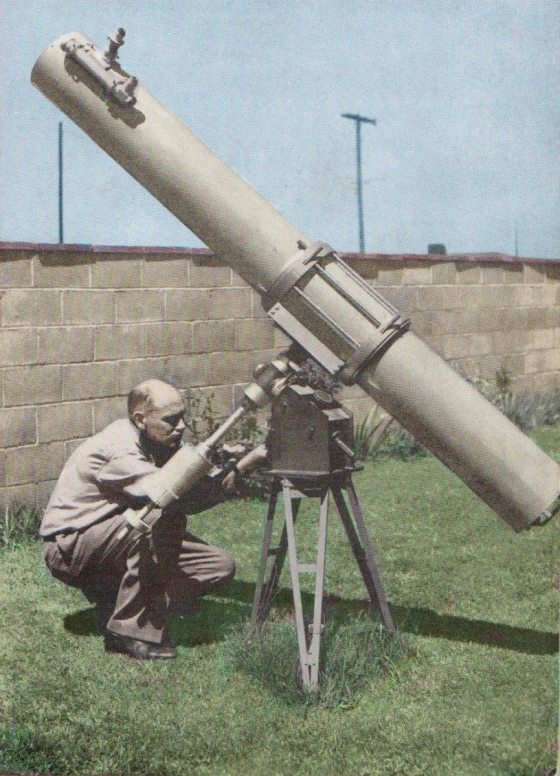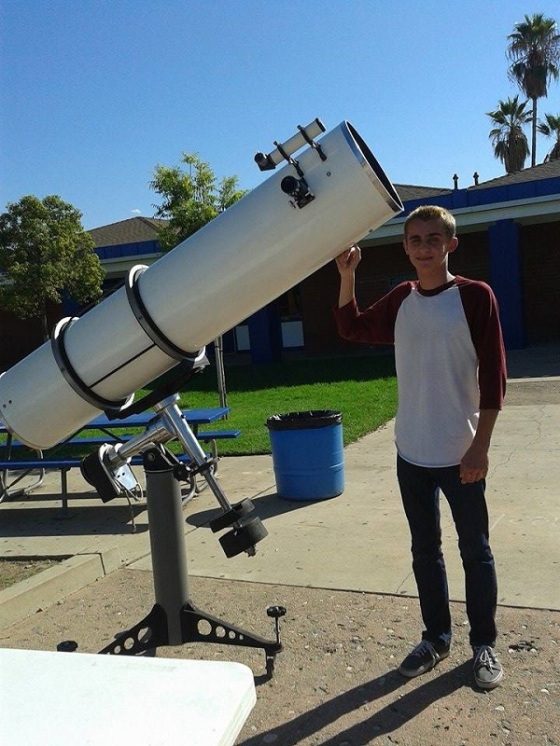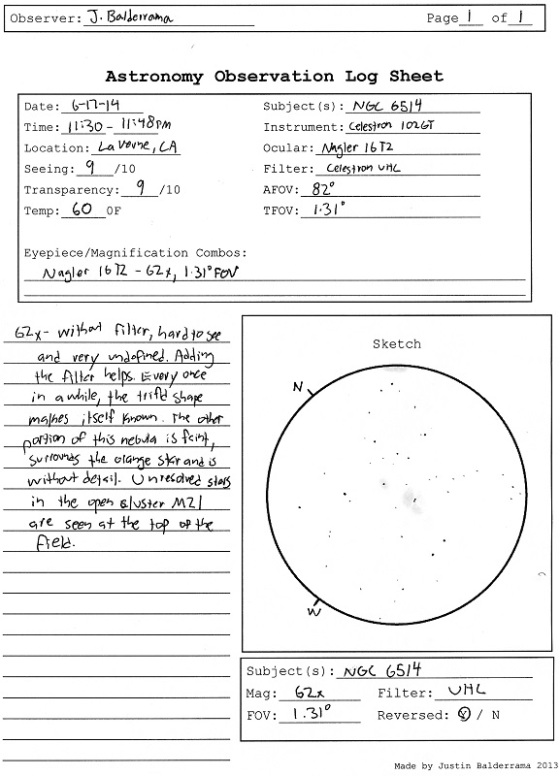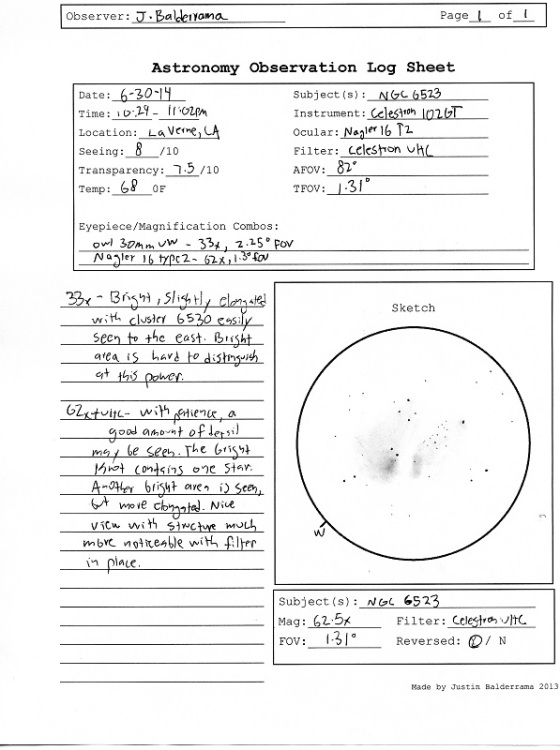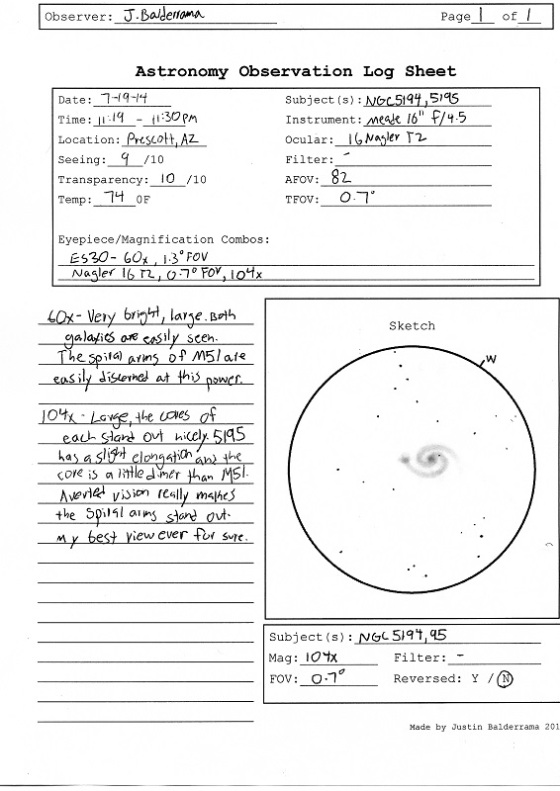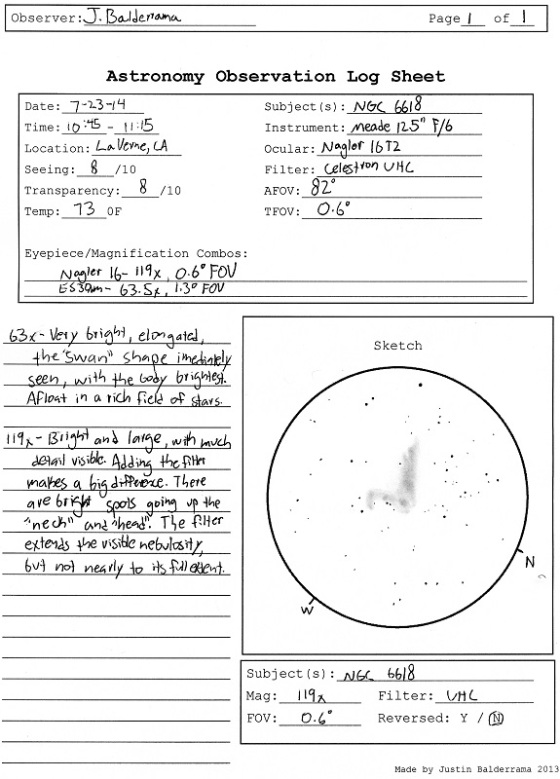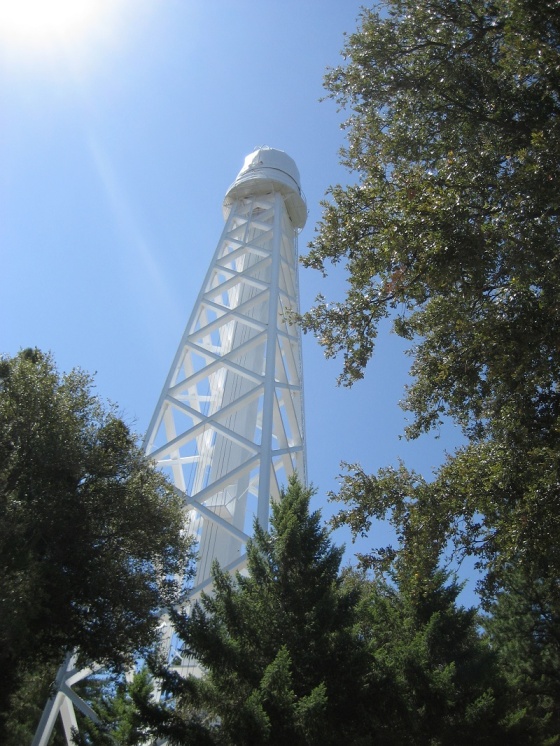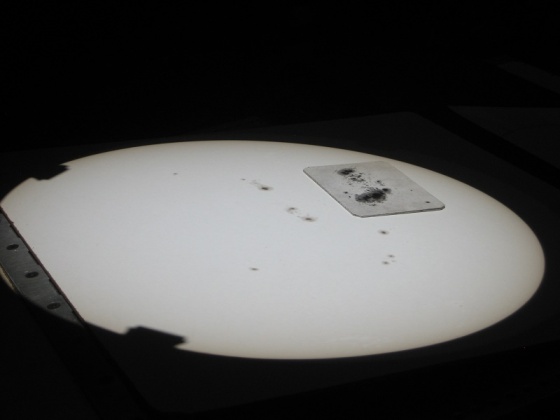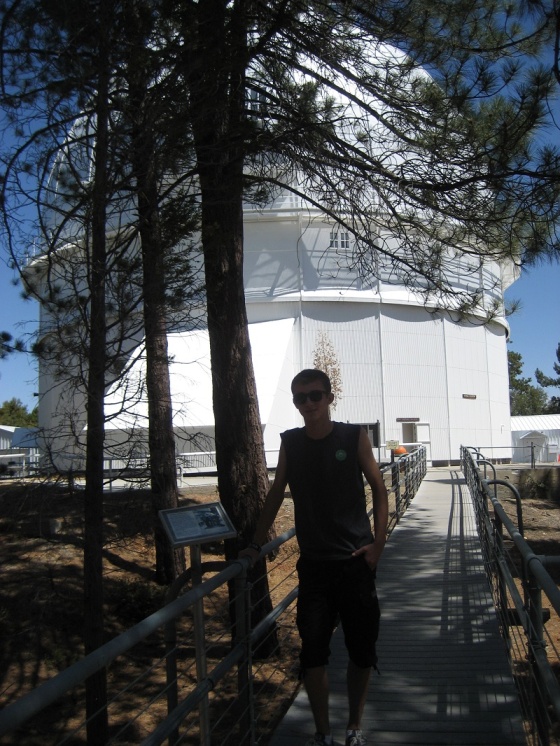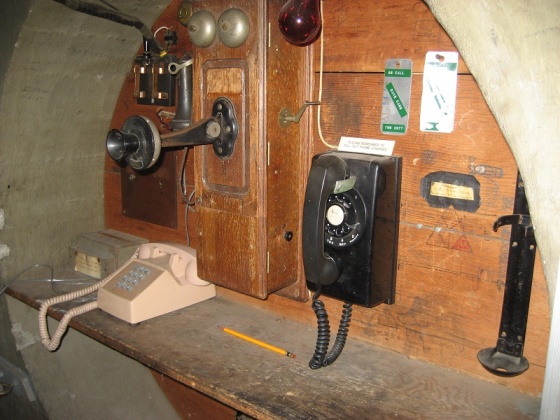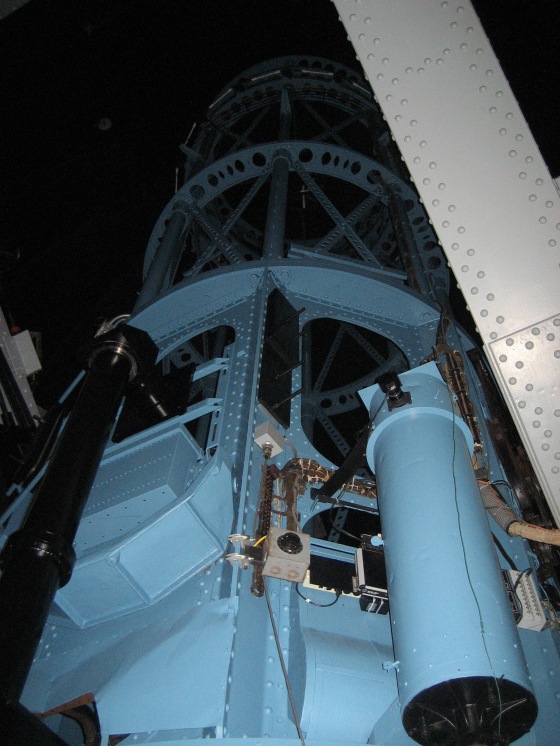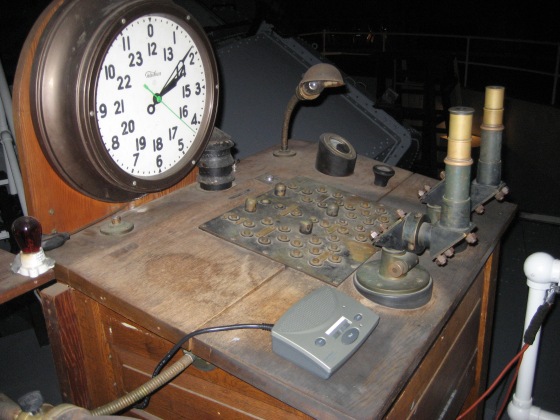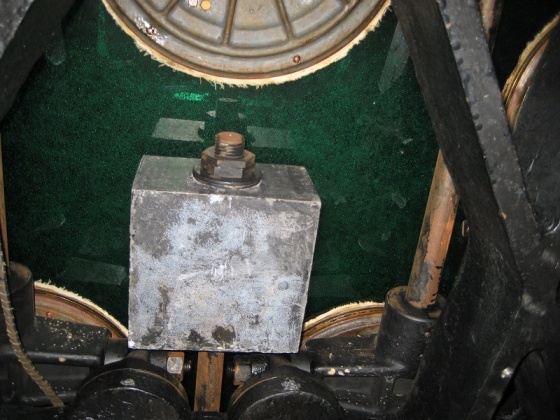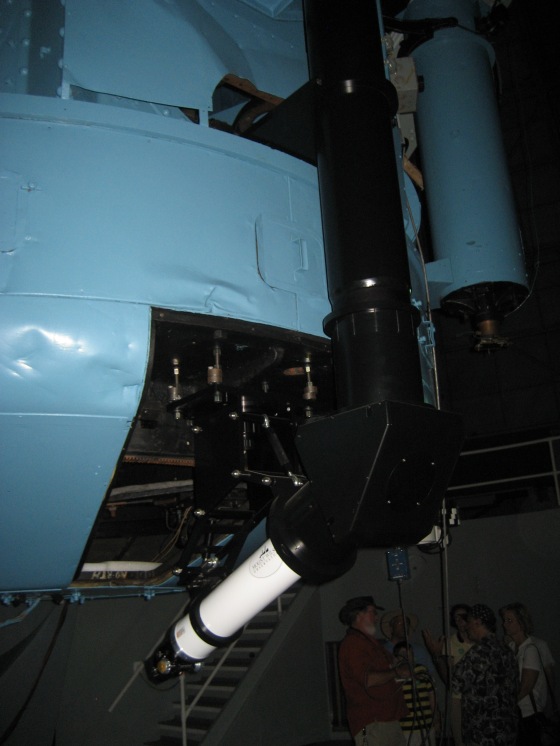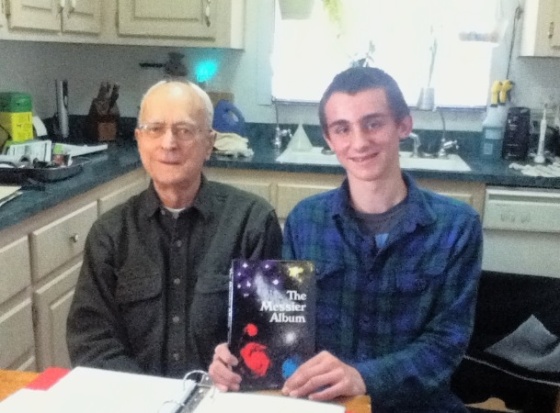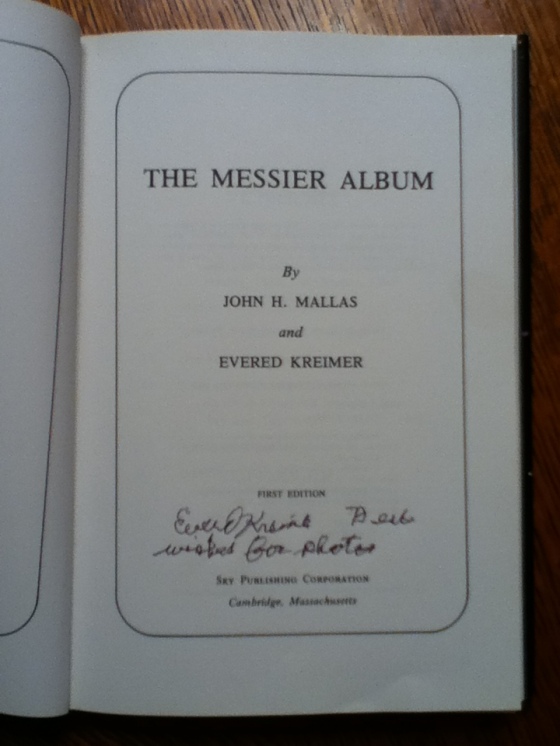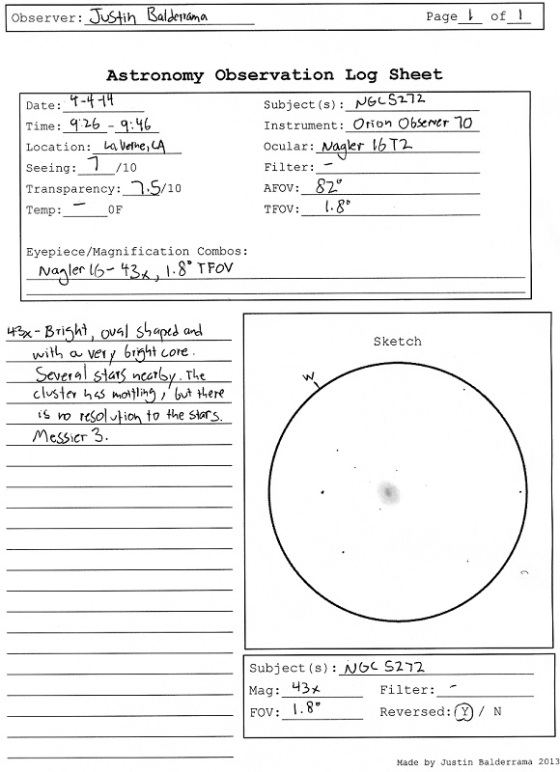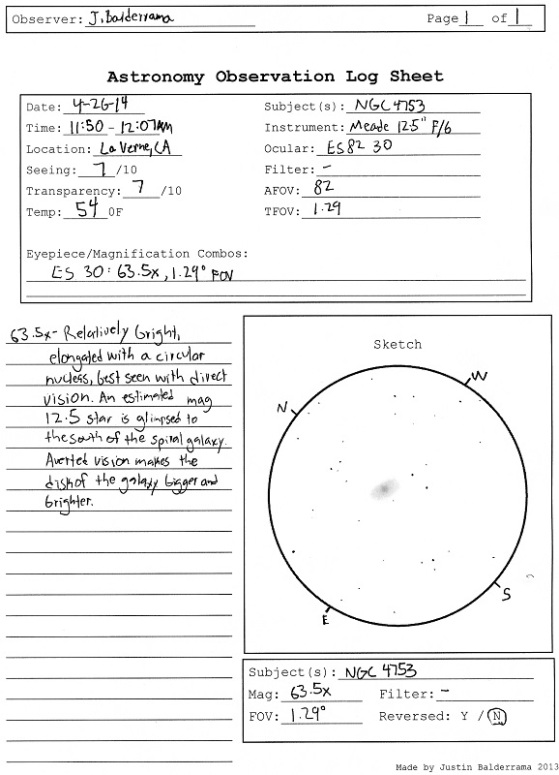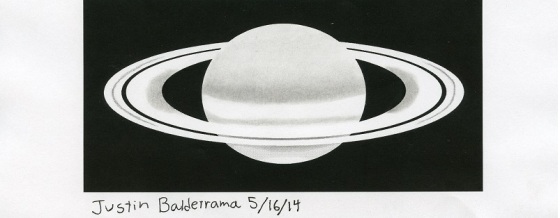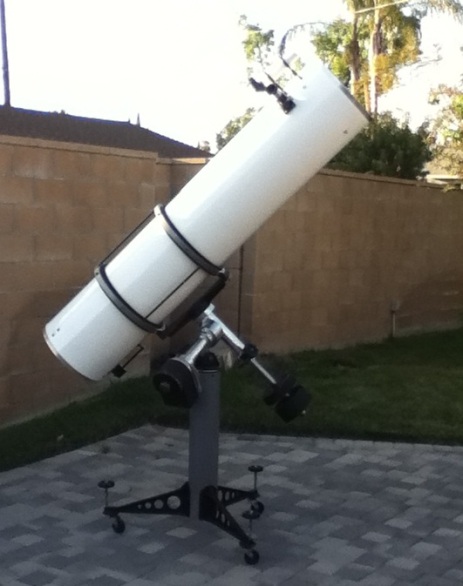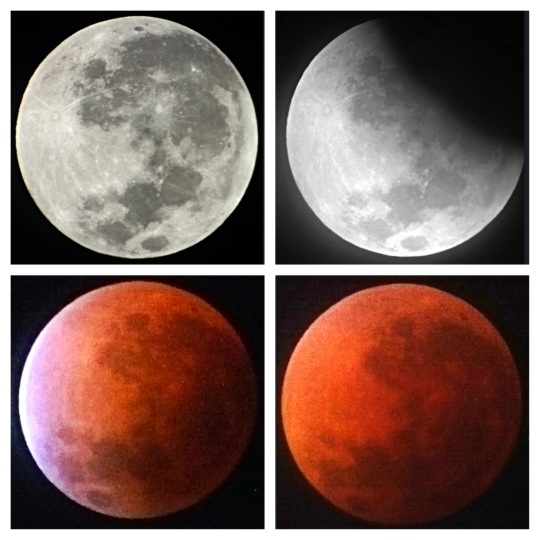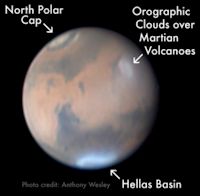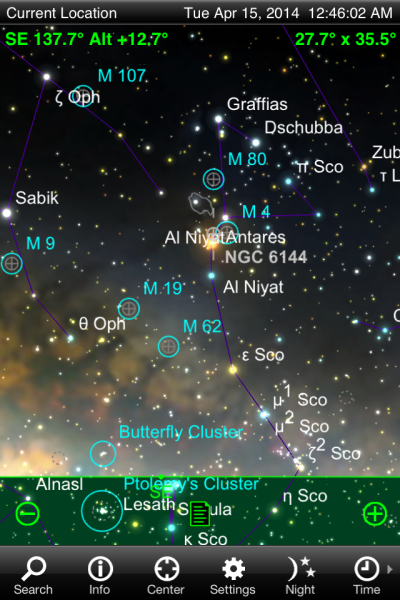It’s been too long! I’m sure you’ve all heard the stories I write on here about Mr Jackson Carle, and his wonderful 8″ scope. Well a complicated series of events have lead to us finding, owning, and in the process of restoring this old telescope. I’ve found photos, magazine articles, the list goes on. The full story to come. Here is a photo of Mr. Carle and his telescope from 1955. I colorized the photo as it was black and white.
San Dimas Astronomy Club
It’s official! I was able to bring the 12.5″ into school to advertise for my newly founded club. At my school, it’s called Club Rush, where all the clubs set up their tables and try to get people to sign up for their club. This was quite a new experience for me as I steered clear of this last year, as it indeed is very busy in the quad.
Last year I brought in the RV-6 to science class and did a talk about telescopes and such and got quite a bit of interest. All the people that were interested signed up the the club. Nobody there could quite come close to showing up that massive telescope sitting out there. Here’s a few photos.
Now, what do we do at the clubs? I already have several ideas in progress, and the good people at Cloudy Nights gave me a few other ideas. But, for this first meeting, I want to gauge the interest level of the group and see who is really passionate that could help me lead and coordinate future events.
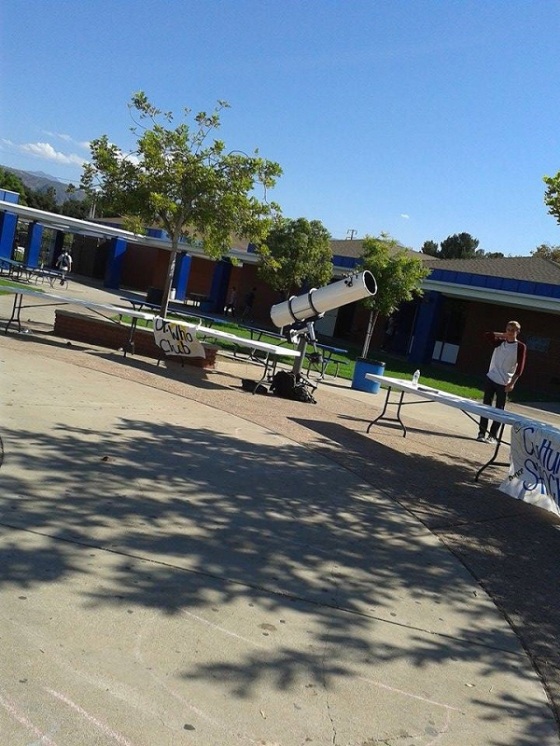
You can see some of the other tables set up with their posters. The ASB actually made me a really cool looking poster but the wind got the best of it after the first day.
A few of my ideas included doing a fundraiser selling some of mom’s famous cookies or some sodas or something to fund a trip up to local observatories like Mount Wilson or Griffith Park. Monrovia High School has an observatory on campus which houses an 11″ Celestron Edge. It would be fun to collaborate with the surrounding schools. I also thought solar outreach at lunchtime at school would further generate interest and more members. The first meeting is planned sometime in early October. Should be really exciting!
September Astronomical Events + Exciting News
Hello to all! Schools back in sesion for me here so I hope I will still have the time to be blogging often. I’ve gotten really lazy and haven’t been updating it like I want to be. In any case, September is shaping up to be a great month for me.
Observing wise, this is a great time of year. You can still catch the summer stuff early on in the evening and get a taste of the exciting fall and winter objects to come. Andromeda is up pretty high by 10PM, and it is a great view on those dark nights.
Pegasus, or the Great Square contains a host of galaxies, namely NGC 7331 and Stephans Quintet, a wonderful, but compact grouping of 5 galaxies. I could not see these from my Red Zone backyard in the 12.5″. On a recent trip to my grandpas house, I got to spend a while on Pegasus and was surprised that they were not that apparent at first, even with the 16″ Newtonian. They are just west of the bright galaxy NGC 7331, which it self is accompanied by a few fainter galaxies. These were easy in the 16″ but in the 12.5″ at home, only 7331 was visible. As far as galaxies go, it’s bright enough to be a Messier, but he did not come across it. The bright planetary NGC 7662, aka, The Blue Snowball is readily visible in the RV-6 from the backyard. It’s nickname is accurate, looks like a blue snowball afloat a field of stars. Larger aperture will show internal structure and a central star.
In the Andromeda/Triangulum area, there is a lot of memorable objects to be seen. Of course, the main attraction is M31, with it’s 2 companions M32 and M110. 110 is the smaller brighter companion, with an almost stellar appearance in small scopes. M32 is larger and fainter, but it can be spied in a 6″ scope from here. The large aperture really brings this grouping to life. The inner dust lane of M31 is glimpsed in the 12.5″ on a dark night here, and the galaxy’s milky light extends out far more than it appears. More can be seen by placing the galaxy outside the field completely and slowly letting it drift into the field. This tecnique also works great on the Orion Nebula. A favorite of mine in Andromeda is NGC 891, an edge on spiral galaxy. The surface brightness is rather low and pretty faint from here, but in Arizona skies with grandpa’s 16″ it is large and bright, with a prominent dark dust lane going down the middle. While in the area, check out NGC 752, a large scattered open cluster near M33. I really like this cluster, and it’s rather overlooked in my opinnion. Seen best with low power and wide fields, it is a real treat from dark skies. The other great galaxy in this region is M33, the Triangulum Galaxy. This is one of the hardest Messiers due to it’s very large size and low surface brightness. From Arizona, it can be seen naked eye, with spiral arms and clusters and nebulae superimposed upon them in the 16″. But until recently, I have been unsucessful in locating it from my backyard, until recently. Once I had the correct stars in the FOV, I waited patiently and after a few minutes was able to make out a soft glow of the galaxy. This was in the 12.5″ with the ES30mm, giving 63.x and a 1.3* FOV. Not a visually memorable view, but I was glad to have finally spotted it.
Comet Jacques (c/2014 e2) has gotten pretty bright in Cassipeia right now, hovering around mag 7. I had it recently in the 12.5″ and it was pretty cool. There nucleas was very apparent, with the coma extending out very far. The tail escaped me that night, but it can only get better. Finder chart here.
In other news, the article on Evered Kreimer will be in the September issue of the quarterly magazine Reflector by the Astronomical League. I’m hoping for it to come any day now, the anticipation is building! I submitted the article to them back in July and I’m eager to see it in print. This is my first article ever in a magazine, and while it is short, it still is a start. Hopefully more to come for the future!
I’m starting an astronomy club at my high schoold, San Dimas High. Signups are the week of September 15, and so far there is quite a bit of interest. I am the founder and president of the club, something I can’t say I’ve had experience in before. Club meetings will be twice month. I’m planning on fundraisers for the club to take a field trip up to Mount Wilson or Griffith Observatory. The signup week I am bringing the big 12.5″ on campus to get people interested enough to sign up. It’ll be quite a job, but I have a feeling it’ll bring in a lot more people.
That’s all for now, I plan to make a photo post about my astronomy club coming soon here, as well as the article for the magazine. Should be really exciting!
Sketches of the Summer
Didn’t think I haven’t been sketching did you now? Summer is coming to a close, at least for me, and the following are that work. I always want to sketch more and more, but it sometimes can be a process more than an hour long, Which is rather difficult standing on a ladder in the dark several feet above the ground. Anyway, here they are. Clicking on each sketch will open the full resolution view.
A Trip to Mount Wilson
Sunday July 6 I was able to take a trip up to Mount Wilson Observatory with my mon and my little brother. In a sentence, It is a spectacular place to visit. There is a rich amount of history with a multitude of places to see and things to do! And a LOT of walking!
It’s a really nice, but lengthy drive up in the mountains to get there, and the road is full of sharp turns. The whole way up I was trying to picture someone driving that big 60″ and that big big 100″ mirror up the very same road.
Anyway we got to go on a tour of the whole place, or you can just walk around. I highly recommend the tour, but only on weekends, where they include visiting the observing floor of the 100″ telescope. There are so many observatories there, I never did a count, but over 5 separate domes, not including another observatory under construction while we were there.
The first place we visited on the tour was the 150 foot solar telescope. This was pretty awesome, and it’s pretty darn hard to miss as well, as you could imagine, it’s a big tower. We were lucky enough to be accompanied one of the people that sketches the sun daily and he showed our tour group inside. Walking through the door was like walking right back into the good ol’ days of astronomy (not that I ever experienced them myself :D). Old equipment in use since it was first put into use since 1912. What was really exciting was the amount of sunspot activity, it was really active that day. There was a sketch of the biggest sunspot they ever recorded put down next to the live sunspots we were seeing, and they were that much smaller! Anyway, there was another small room with some really old computers, I have no idea what they were but they had the old reels like you see in the Apollo 13 movie! There is a live camera on the top of the tower that can be see here.
We briefly walked by the 60″ dome, but we did not get to go inside. Here’s a comparison shot of me next to the “smaller” dome:
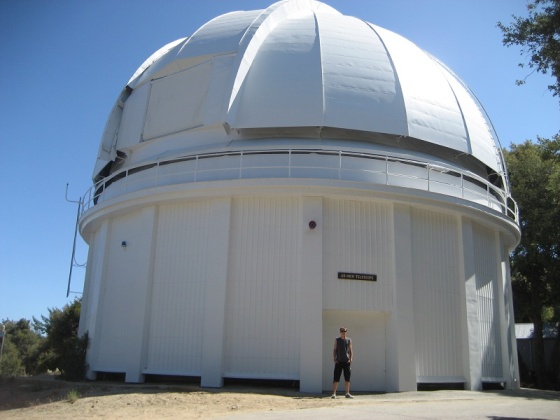 Next we got to check out the 100″ telescope. This is where it gets really interesting. This is a telescope that I’ve only seen in photos, and even the photos I’ve taken don’t come close to showing the sheer size and mass of it. Just up the road a little further from the 60″ dome lies the 100″ telescope across a bridge, a bridge where there is a plaque showing a photo of Albert Einstein standing on the bridge with a few other notable scientists.
Next we got to check out the 100″ telescope. This is where it gets really interesting. This is a telescope that I’ve only seen in photos, and even the photos I’ve taken don’t come close to showing the sheer size and mass of it. Just up the road a little further from the 60″ dome lies the 100″ telescope across a bridge, a bridge where there is a plaque showing a photo of Albert Einstein standing on the bridge with a few other notable scientists.
I’ve taken several photos of the inside of the observatory, but like I said, they don’t do it the justice it deserves. If your not taking the tour and just walking around, there is an area to the left of the observatory open to a small viewing area with some large windows looking into the observatory. Before the tour began, we walked around and went into this room, and stared in awe at the telescope through the window. but being up close and personal with it is a whole different experience. On our tour, we get to go up a different way to the observing floor. Through the door pictured above in the background is what is like a large garage, there is even a garage door on the side! Then starts the stairs. And more stairs. And more stairs. Up the first flight is a small area with a phone booth, showing different phones used throughout the time of the observatory. They just never got rid of anything!
And now, the moment you’ve all been waiting for, we enter the observing floor of the 100 inch. Well, the first impressions are, as you might imagine, that it’s big!! It’s much bigger standing next to it than looking through a window. I remember reading about the silvering chamber under the floor where the mirror is pulled out for recoating every few months, and clear as day is this big circle where a very large and heavy mirror is lowered. We got to go upstairs onto the part where the dome rotates, and controls. Here’s some photos.
This next photo is pretty cool, because it shows up inside the mirror cell and looking at the primary mirror. The primary mirror is made of plate glass, and it one solid piece. It weighs 9000 pounds and is 12″ thick. In the photo you can see the back side of the mirror (green) and you can see some of the pads that support it.
Well, the last set of photos I have is a fairly recent modification for visual use that seats the eyepiece to a much more comfortable angle. It appears that there has been a modification to shoot the light gathered from the 100 inch mirror down at the back of the telescope, by means of a huge prism and a refractor tube equipped with a 2″ Crayford focuser.
Here is a link to a great article on the history of this telescope. Link. That’s about all I’ve got for photos. After the observatory, we went out to a special viewing spot called Echo point, with a beautiful view of the entire area, we could easily see the ocean and Catalina Island and even San Clemente Island. All in all, it was an awesome trip, a lot of walking, and a lot of fun. I’d highly recommend taking a trip up to Mount Wilson, you won’t be disappointed. I’d love to go back soon and do some observing with their big telescopes!
A Meeting with Evered Kreimer
It’s taken me way too long to get around to posting about this, but I had the opportunity to meet Evered Kreimer, the famous astrophotographer who first used the cooled emulsion camera.
Evered Kreimer was a big name in amateur astronomy back in the 60’s and 70’s. He had a contract with Sky and Telescope magazine and had his photos included monthly. He became interested in astronomy when he was a teenager. He moved to Prescott, Arizona in 1962 and built his observatory, housing a Cave 12.5″ F/7 Newtonian. Later on he moved to another part of Prescott and built another observatory. He also had his own imaging processing room, to process and develop the Kodak Tri-X film that he used on his photographs.
One of his biggest contribution was being co-author in the book, The Messier Album published in 1978. This book included information, sketches and photos off all the Messier objects as well as the history of Charles Messier. This is a popular book among astronomers looking for a quick reference on any Messier object. Kreimer included all the photos and John Mallas included the sketches of all the objects as seen through his 4″ Unitron Refractor. This book is still available today, look here.
Anyway. no one has heard of him recently at all, not for the last several years. During a trip visiting my grandparents in Prescott (from 2/14), we managed to get ahold of him and he invited us down to visit him. Kreimer showed us his photos and told us his story.
About 5 years ago, Kreimer gave away his telescope and sold his house, the observatory was torn down. He moved to a quiet, beautiful neighborhood in Prescott. He still is into photography, while he can’t get out under the stars anymore, he photographs birds, and has since switched to digital. He has a small spotting scope that he carries around now. Kreimer is still sharp as a tack, and he knows his stuff. He is 92. My grandpa and him really connected, he worked in a photo lab for over 30 years and did some astrophotography of his own with his 12.5″ F/6 Newtonian. They were both talking about how they did all the image processing, chemicals used, etc. Kreimer took a particular liking to my sketches, and it was fun comparing sketches with his photos. He told me that in the 36 years The Messier Album has been out, he never received one letter, one phone call, nothing. I’m the very first.
It was a real honor to talk with him, and is a really kind man. He signed my book:
This is the only signature in The Messier Album, and I’m so honored to have it be my copy. Thanks to all, who made this possible, my parents, my grandparents, and, of course, Mr. Kreimer.
May Meteor Storm
There is a possible large meteor storm occurring this evening! It should produce a large amount of meteors if predictions are accurate. This is not a “shower”, but known as a storm. The difference is that the shower produces a show over a period of a few weeks while this storm is only to last a few hours. That being said, you’ll still be able to see meteors here and there, but the large concentration is tonight.
The storm should start around 11:30 PM tonight and end around 2:30 AM Saturday morning (PST). There are several time zones posted here, so it shouldn’t be a problem for you to find. The radiant of the storm is near the North Star. this only means that the trails produced by the meteors will be pointing to this vicinity, so you are equally likely to see the meteors from any point in the sky. Hopefully the weather will hold out for a nice view, as this could be a potentially large output of meteors up to 1000. My opinion is this is a bit over optimistic, but you never know until you look!
Some More Sketches
I’ve made quite a few sketches the last month or so. The recent Mars Opposition made for some great views of the red planet, and I made my first Mars sketch since 2012! I sketched it with the RV-6 on 5/3/14 at 277x. The seeing was excellent.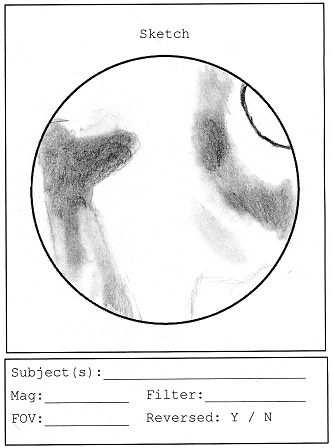
My next sketch is one of the bright globular cluster M3, or NGC 5272. I sketched it with the Orion Observer 70 and the 16 Nagler. It was nice to have such a wide apparent and true field and some decent magnification. As usual, clicking the photo will show the full resolution view.
Quick question for you, do you prefer seeing the close up “Presentation” view like the Mars sketch, or is the full scanned page better? Moving right along, another sketch I did was spiral galaxy NGC 4753. I highly recommend this galaxy. It was pretty nice and bright, and punched through the light pollution pretty well. Definitely worth a look. Sketched with the 12.5″.
Here is my most recent sketch, one of Saturn I did just the other day. It is my best view of Saturn to date. I got this Saturn template from Jeremy Perez’s website, you can download it here. Using the 7mm Galoc ortho and a 2x Shorty barlow I had the power racked out to 544x! The seeing was really steady and if I could put more power on it, it would have been able to handle it. On this sketch, most notable is Encke’s Division, the furthermost gap in the rings. The largest gap is called Cassini’s division.
Lunar Eclipse 2014
I set up the reflectors for the Eclipse on the 14th. This was my very first lunar eclipse, and I’ll say, it was spectacular.
As expected, the Eclipse started around 11:00, seen as a dark protrusion on one side. The image of the moon dramatically changed over a period of just a few minutes. My little brother Kevin joined and took control of the RV-6, and really enjoyed swapping out eyepieces. It was a lot of fun, and he was very impressed with the views. I was using the 12.5″ and the moon is so bright my eye started to hurt after a while. Kevin came over and enjoyed several minutes on the stepladder intently watching the eclipse. I think he may have an early case of aperture fever!
The shadow continued to creep over surface, gobbling up crater after crater into the inky shadow. I could still see the features, but they were faint in the shadow. Eventually, a soft orange glow came over the shadow area and made the features more pronounced. I created a 4 photo montage showing the stages of the event.
I edited the photos to bring out the red orange coloring, and to make the surface features more apparent. In reality it appeared more subdued. As Lunar totality arrived, I noticed that my surroundings had drastically changed. For one, it was very dark, and many stars came out. Usually on a full moon all but the very brightest stars are washed out, but now with the eclipsed moon, it was dark like a night without a moon. Also, it became very quiet. The crickets ceased their chirping and the wind had finally settled down. It was amazing watching the eclipse. There was scattered clouds throughout the evening, but I managed to get excellent views. During totality, a cloud would pass over and it would turn the same color as the moon. Soon after totality, I had to go to bed, as it was a school night!
As much as I would have loved to make a sketch of the moon, during this event, sketching anything lunar is extremely difficult for me. Deep sky? No problem. Planets? I can do it. Lunar? No way! There is another lunar eclipse this October, and hopefully it will be as exciting as this one was. I’m glad I got to experience this, even though it happens relatively often. It’s always nice to have a total lunar eclipse as your first one! I found that the views through my 40mm finder scopes were spectacular, just as good as through the big scope and the RV-6. In this case, it’s not aperture that counts as much as magnification, which should be low. In any case, a lunar eclipse is really fun to experience, telescope or not.
April Astronomical Events
This month presents a host of exciting objects and events for us observers, ranging from Mars, Lunar Eclipses and the return of the ringed planet! As in my previous Astronomical Events posts, I am highlighting what’s to come throughout the month. Let’s get right into it!
For starters, we have the opposition of Mars coming up on April 8th, and should provide a spectacular show. A few nights ago I was out with the 12.5″ Newtonian observing Mars. The best view was with a 7mm Galoc Ortho at 272x, showing off the Polar Ice Caps, intricate light and dark areas, and Orographic Clouds. These are of particular interest. Ever noticed that even on clear days from the city, you notice those clouds always surrounding mountains? The high altitude of the mountains creates what is called micro-climates, and the same effect can be seen on Mars, but on a much bigger scale. Mars is home to the largest volcano in the Solar System, Olympus Mons. Because it’s so large, it creates a micro-climate so large, the cloud systems produced can be seen even from Earth.
The image Mr. Wesley has made here is very similar to what I have been seeing in my 12.5″ telescope. When the Orographic Clouds are near the edge of the planet (from our point of view), they can be sometimes mistaken for a polar cap. Back when I was doing my first observations of Mars in 2012, I was often confused as to why I was seeing a “3rd” Polar Cap. In the small 70mm aperture, the details are much less distinguishable than in the much large scopes I have today.
On the evening of the 14th-15th, there will be a Lunar Eclipse occuring. This will be the first one I have ever seen before, it will certainly be an exciting experience for me. What’s also neat and unique about this is that even though the Opposition of Mars is on the 8th, technically we are closest to it on the same evening as the eclipse. Mars’ brightness will appear the same as it did on the 8th. Now the lunar eclipse has 2 main stages that it goes through, the partial eclipse, and the total. The total is certainly the climax of the event. The Eclipse begins at 10:58 PM (PDT). This is the beginning of the partial eclipse. The whole event will last a most of the night, fully ending at 2:33 AM. The absolute best time peak of the event occurs at 12:46 AM, with the Full Moon turning an orange red color. With the red moon and Mars, it will be spectacular!
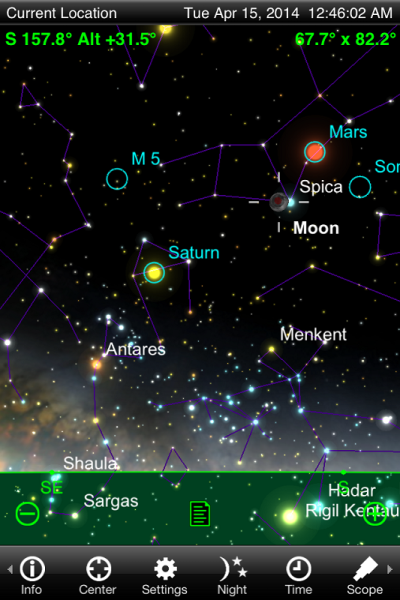
This is a Sky Safari screenshot of the location of Mars and the Moon at the peak of the lunar eclipse.
The chief object are very similar to last month’s, but with a few additions. M5, a globular cluster in Serpens is big and bright, and is right up there with M13, M3, and M22. Later in the evening expect to see Scorpio rising, as well as Ophiuchus. The nice globulars M10, M12, M107 reside in the western half, and faint M14 in the eastern part. M4 is a bright globular right by Antares, very easy to find. Has an interesting bar shaped core. In a wide field eyepiece, try to spot NGC 6144, just to the northeast or M4. It can be seen from light polluted skies in a 6″ telescope. M80 is another nice globular in Scorpio, similar to M92, but fainter. If you can stay out late enough, you might get glimpses of open clusters M6 and M7. M7 is one of my summer favorites. Of course there is still plenty to see in the Coma-Virgo area, thousands of galaxies actually. There is certainly no shortage of objects this time of year!
